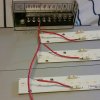- Joined
- Jul 13, 2017
- Messages
- 1,495
- Reputation
- 740
- Reaction score
- 4,756
- Points
- 0
- Currently Smoking
- Oinker RyBZ™ & Moocow Brisket
Would u know if that particular driver is of the Constant Current or Constant Voltage type? I'm pretty sure with the Mean Well HLG series, the ones that end in 24, 36, 48 are constant voltage, and the ones ending in 700, 1050, 1400,/1750, 2100 etc are constant current. I use Constant Current drivers as noted by their C status. Like HLG-240h-C1050x. The C before the 1050 means its Constant Current @ 1050ma. Anyway, I have ALWAYS wired the C series Mean Well in series wiring, and the other series in parallel. For example, I am building a COB as we speak with my buddy. We are using the HLG-185-36a driver in parallel with 4 Citizen 1212s. So the instructions you gave me are for parallel wiring for your ebay driver. So I am gonna assume its not a CC driver, but a constant Voltage driver. Basically, treat every one of the 10 strips as its very own "unit." Each unit has a + and a - terminal (Red + /Black - ). Basically make sure that every + on the whole kit is hooked together to the red + output of the driver and all of the - is hooked together and gets to the black - side of driver output. I'm sure your kit plays nice together of you don't fuck up. Make sure to keep your wiring neat. No stray wires or bare copper. Use wire nuts
Sent from my XT1254 using Tapatalk
Sent from my XT1254 using Tapatalk








 I apologize for my.. Lack of brain usage. But hey.. I learned some shit!
I apologize for my.. Lack of brain usage. But hey.. I learned some shit!